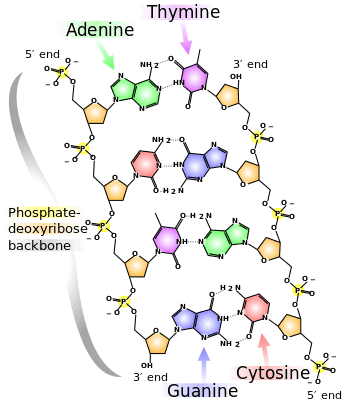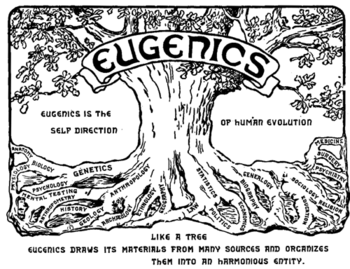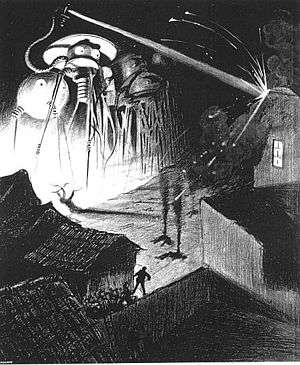Genetics in fiction
.jpg)
Aspects of genetics including mutation, hybridisation, cloning, genetic engineering, and eugenics have appeared in fiction since the 19th century.[1][2]
Genetics is a young science, having started in 1900 with the rediscovery of Gregor Mendel's study on the inheritance of traits in pea plants. During the 20th century it developed to create new sciences and technologies including molecular biology, DNA sequencing, cloning, and genetic engineering. The ethical implications were brought into focus with the eugenics movement.
Since then, many science fiction novels and films have used aspects of genetics as plot devices, often taking one of two routes: a genetic accident with disastrous consequences; or, the feasibility and desirability of a planned genetic alteration. The treatment of science in these stories has been uneven and often unrealistic. The film Gattaca did attempt to portray science accurately but was criticised by scientists.
Context
Background

Modern genetics began with the work of Gregor Mendel in the 19th century on the inheritance of traits in pea plants. He found that traits were inherited discretely, rather than by blending the attributes of the two parents.[3] In 1900, Hugo de Vries and other scientists rediscovered Mendel's research; William Bateson coined the term "genetics" for the new science, which soon investigated a wide range of phenomena including mutation, genetic linkage, and hybridisation.[4] Eugenics, the production of better human beings by selective breeding, was named and advocated by Francis Galton in 1883.[5][6] Molecular biology began with the identification in 1944 of DNA as the genetic material;[7] the genetic code and the double helix structure of DNA was determined by James Watson and Francis Crick in 1953.[8][9] DNA sequencing by chain-termination sequencing was developed in 1977 by Frederick Sanger.[10] Genetic engineering became possible in 1972 when Paul Berg created the first recombinant DNA molecules using viruses.[11] Cloning was shown to be practicable with the creation of Dolly the sheep from an adult somatic cell in 1996 at the Roslin Institute.[12]
Myth and oversimplification
The geneticist Dan Koboldt observes that while science and technology play major roles in fiction, from fantasy and science fiction to thrillers, the representation of science in both literature and film is often unrealistic.[1] In Koboldt's view, genetics in fiction is frequently oversimplified, and some myths are common and need to be debunked. For example, the Human Genome Project has not (he states) immediately led to a Gattaca world, as the relationship between genotype and phenotype is not straightforward. People do differ genetically, but only very rarely because they are missing a gene that other people have: people have different alleles of the same genes. Eye and hair colour are controlled not by one gene each, but by multiple genes. Mutations do occur, but they are rare: people are 99.99% identical genetically, the 3 million differences between any two people being dwarfed by the hundreds of millions of DNA bases which are identical; nearly all DNA variants are inherited, not acquired afresh by mutation. And, Koboldt writes, believable scientists in fiction should know their knowledge is limited.[2]
Genetics themes
Mutants and hybrids
Mutation and hybridisation are widely used in fiction, starting in the 19th century with science fiction works such as Mary Shelley's 1818 novel Frankenstein and H. G. Wells's 1896 The Island of Dr Moreau.[13] The plot devices allow for two major types of story, identified by Helen Parker in her 1977 Biological Themes in Modern Science Fiction: "genetic accident, the uncontrolled and unexpected alteration of a species",[14][15] with disastrous consequences; and the "feasibility and desirability of planned genetic alteration, changes controlled either by man or by an alien force".[14][15] In early science fiction, the changes were brought about by radiation, breeding programmes, or manipulation with chemicals or surgery (and thus, notes Lars Schmeink, not necessarily by strictly genetic means). After the double helix and then recombinant DNA, genetic engineering became the focus for genetics in fiction.[15]
Comic books imagine mutated superhumans with extraordinary powers. The DC Universe imagines "metahumans"; the Marvel Universe calls them "mutants", while the Wildstorm and Ultimate Marvel Universes name them "posthumans".[16]
James Blish's 1952 Titan's Daughter (in Kendell Foster Crossen's Future Tense collection) featured stimulated polyploidy, based on spontaneous polyploidy in flowering plants, to create giant humans.[17]
Cloning

Cloning, too, is a familiar plot device. In his novel Jurassic Park, Michael Crichton imagined the recovery of the complete genome of a dinosaur from fossil remains, followed by its use to recreate living animals of an extinct species.[13] Aldous Huxley's 1931 dystopian novel Brave New World imagines the in vitro cloning of fertilised human eggs.[18][19] Huxley was influenced by J. B. S. Haldane's 1924 non-fiction book Daedalus; or, Science and the Future, which used the Greek myth of Daedalus to symbolise the coming revolution in genetics; Haldane predicted that humans would control their own evolution through directed mutation and in vitro fertilisation.[20] Cloning was explored further in stories such as Poul Anderson's 1953 UN-Man.[21]
Cloning is a recurring theme in science fiction films like Jurassic Park (1993), Alien Resurrection (1997), The 6th Day (2000), Resident Evil (2002), Star Wars: Episode II (2002) and The Island (2005). The process of cloning is represented variously in fiction. Many works depict the artificial creation of humans by a method of growing cells from a tissue or DNA sample; the replication may be instantaneous, or take place through slow growth of human embryos in artificial wombs. In the long-running British television series Doctor Who, the Fourth Doctor and his companion Leela were cloned in a matter of seconds from DNA samples ("The Invisible Enemy", 1977) and then—in an apparent homage to the 1966 film Fantastic Voyage—shrunk to microscopic size in order to enter the Doctor's body to combat an alien virus. The clones in this story are short-lived, and can only survive a matter of minutes before they expire.[22] Films such as The Matrix and Star Wars: Episode II – Attack of the Clones have featured human foetuses being cultured on an industrial scale in enormous tanks.[23]
Cloning humans from body parts is a common science fiction trope, one of several genetics themes parodied in Woody Allen's 1973 comedy Sleeper, where an attempt is made to clone an assassinated dictator from his disembodied nose.[24]
Genetic engineering
Genetic engineering features in many science fiction stories.[17] Films such as The Island and Blade Runner bring the engineered creature to confront the person who created it or the being it was cloned from, a theme seen in some film versions of Frankenstein. Few films have informed audiences about genetic engineering as such, with the exception of the 1978 The Boys from Brazil and the 1993 Jurassic Park, both of which made use of a lesson, a demonstration, and a clip of scientific film.[13][25] In 1982, Frank Herbert's novel The White Plague described the deliberate use of genetic engineering to create a pathogen which specifically killed women.[17] Another of Herbert's creations, the Dune series of novels, starting with Dune in 1965, emphasises genetics. It combines selective breeding by the Bene Gesserit to produce the Kwisatz Haderach with the genetic engineering of the Tleilaxu.[26]

Genetic engineering methods are weakly represented in film; Michael Clark, writing for The Wellcome Trust, calls the portrayal of genetic engineering and biotechnology "seriously distorted"[25] in films such as Roger Spottiswoode's 2000 The 6th Day, which makes use of the trope of a "vast clandestine laboratory ... filled with row upon row of 'blank' human bodies kept floating in tanks of nutrient liquid or in suspended animation". In Clark's view, the biotechnology is typically "given fantastic but visually arresting forms" while the science is either relegated to the background or fictionalised to suit a young audience.[25]
Eugenics
Eugenics plays a central role in films such as Andrew Niccol's 1997 Gattaca, the title alluding to the letters G, A, T, C for guanine, adenine, thymine, and cytosine, the four nucleobases of DNA. Genetic engineering of humans is unrestricted, resulting in genetic discrimination, loss of diversity, and adverse effects on society. The film explores the ethical implications; the production company, Sony Pictures, consulted with a gene therapy researcher, French Anderson, to ensure that the portrayal of science was realistic, and test-screened the film with the Society of Mammalian Cell Biologists and the American National Human Genome Research Institute before its release. This care did not prevent researchers from attacking the film after its release. Philim Yam of Scientific American called it "science bashing"; in Nature Kevin Davies called it a ""surprisingly pedestrian affair"; and the molecular biologist Lee Silver described the film's extreme genetic determinism as "a straw man".[27][28]
See also
References
- 1 2 Koboldt, Daniel (2018). "Putting the Science in Fiction". Retrieved 19 July 2018.
- 1 2 Koboldt, Daniel (1 August 2014). "Genetics Myths in Fiction Writing". Retrieved 19 July 2018.
- ↑ Blumberg, Roger B. "Mendel's Paper in English". Archived from the original on 13 January 2016.
- ↑ Bateson, W. (1907). "The Progress of Genetic Research". In Wilks, W. Report of the Third 1906 International Conference on Genetics: Hybridization (the cross-breeding of genera or species), the cross-breeding of varieties, and general plant breeding. Royal Horticultural Society.
- ↑ Claude Moore Health Sciences Library (2004). "Origins of Eugenics: From Sir Francis Galton to Virginia's Racial Integrity Act of 1924". University of Virginia. Retrieved 20 July 2018.
- ↑ James D., Watson; Berry, Andrew (2009). DNA: The Secret of Life. Knopf.
- ↑ Avery, OT; MacLeod, CM; McCarty, M (1944). "Studies on the Chemical Nature of the Substance Inducing Transformation of Pneumococcal Types: Induction of Transformation by a Desoxyribonucleic Acid Fraction Isolated from Pneumococcus Type III". The Journal of Experimental Medicine. 79 (2): 137–58. doi:10.1084/jem.79.2.137. PMC 2135445. PMID 19871359. Reprint: Avery, OT; MacLeod, CM; McCarty, M (1979). "Studies on the chemical nature of the substance inducing transformation of pneumococcal types. Inductions of transformation by a desoxyribonucleic acid fraction isolated from pneumococcus type III". The Journal of Experimental Medicine. 149 (2): 297–326. doi:10.1084/jem.149.2.297. PMC 2184805. PMID 33226.
- ↑ Judson, Horace (1979). The Eighth Day of Creation: Makers of the Revolution in Biology. Cold Spring Harbor Laboratory Press. pp. 51–169. ISBN 0-87969-477-7.
- ↑ Watson, James D.; Crick, Francis H. (1953). "Molecular Structure of Nucleic Acids: A Structure for Deoxyribose Nucleic Acid" (PDF). Nature. 171 (4356): 737–8. Bibcode:1953Natur.171..737W. doi:10.1038/171737a0. PMID 13054692. Archived (PDF) from the original on 4 February 2007.
- ↑ Brown, T. A. (2002). "Section 2, Chapter 6: 6.1. The Methodology for DNA Sequencing". Genomes 2 (2nd ed.). Oxford: Bios. ISBN 1-85996-228-9. Archived from the original on 1 September 2007.
- ↑ Jackson, D. A.; Symons, R. H.; Berg, P. (1 October 1972). "Biochemical Method for Inserting New Genetic Information into DNA of Simian Virus 40: Circular SV40 DNA Molecules Containing Lambda Phage Genes and the Galactose Operon of Escherichia coli". PNAS. 69 (10): 2904–2909. Bibcode:1972PNAS...69.2904J. doi:10.1073/pnas.69.10.2904. PMC 389671. PMID 4342968.
- ↑ Edwards, J. (1999). "Why dolly matters: Kinship, culture and cloning". Ethnos. 64 (3–4): 301–324. doi:10.1080/00141844.1999.9981606.
- 1 2 3 Moraga, Roger. "Modern Genetics in the World of Fiction". Clarkesworld magazine. Retrieved 19 July 2013.
- 1 2 Parker, Helen N. (1977). Biological Themes in Modern Science Fiction. UMI Research Press. Login required.
- 1 2 3 Schmeink, Lars (2017). Biopunk Dystopias Genetic Engineering, Society and Science Fiction. Liverpool University Press. pp. 8–. ISBN 978-1-78138-332-2.
- ↑ Burlingame, Russ (4 October 2014). "The Flash: What are Metahumans?". Comicbook.com. Retrieved 23 July 2016.
- 1 2 3 "Genetic Engineering". The Encyclopedia of Science Fiction. 15 May 2017. Retrieved 19 July 2018.
- ↑ Huxley, Aldous (2005). Brave New World and Brave New World Revisited. HarperPerennial. p. 19. ISBN 978-0060776091.
- ↑ Bhelkar, Ratnakar D. (2009). Science Fiction: Fantasy and Reality. Atlantic Publishers & Dist. p. 58. ISBN 9788126910366.
- ↑ More, Max; Vita-More, Natasha (April 2013). The Transhumanist Reader: Classical and Contemporary Essays on the Science, Technology, and Philosophy of the Human Future. ISBN 978-1-118-33429-4.
- ↑ Stableford, Brian M. (2006). "Clone". Science Fact and Science Fiction: An Encyclopedia. Taylor & Francis. pp. 91–92. ISBN 9780415974608.
- ↑ Muir, John Kenneth (2007). A Critical History of Doctor Who on Television. McFarland. pp. 258–259. ISBN 9781476604541.
- ↑ Mumford, James (2013). Ethics at the Beginning of Life: A Phenomenological Critique. Oxford University Press. p. 108. ISBN 0199673969.
- ↑ Humber, James M.; Almeder, Robert (1998). Human Cloning. Springer. p. 10. ISBN 978-1592592050.
- 1 2 3 Clark, Michael. "Genetic themes in fiction films: Genetics meets Hollywood". The Wellcome Trust. Archived from the original on 18 May 2012. Retrieved 19 July 2018.
- ↑ Koboldt, Daniel (29 August 2017). "The Science of Sci-Fi: How Science Fiction Predicted the Future of Genetics". Outer Places. Retrieved 19 July 2018.
- ↑ Zimmer, Carl (November 10, 2008). "Now: The Rest of the Genome". The New York Times.
- ↑ Kirby, David A. (July 2000). "The New Eugenics in Cinema: Genetic Determinism and Gene Therapy in "GATTACA"". Science Fiction Studies. 27 (2): 193–215. JSTOR 4240876.
